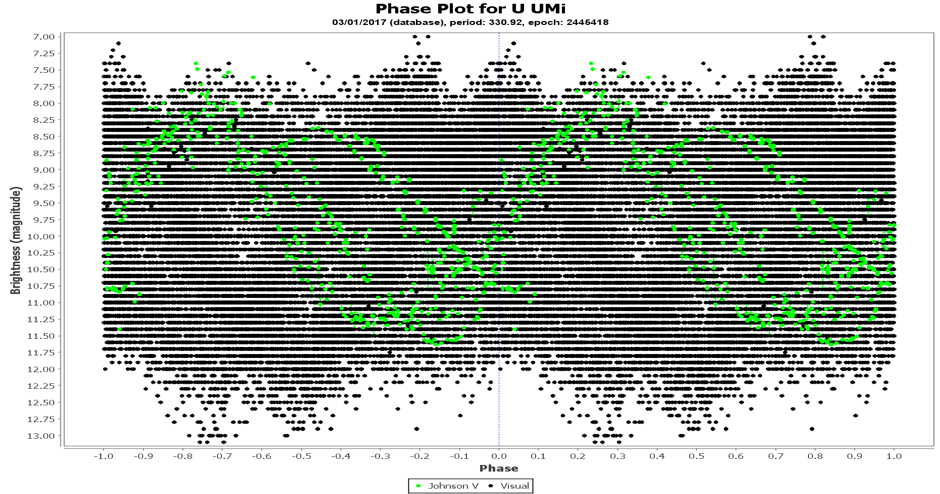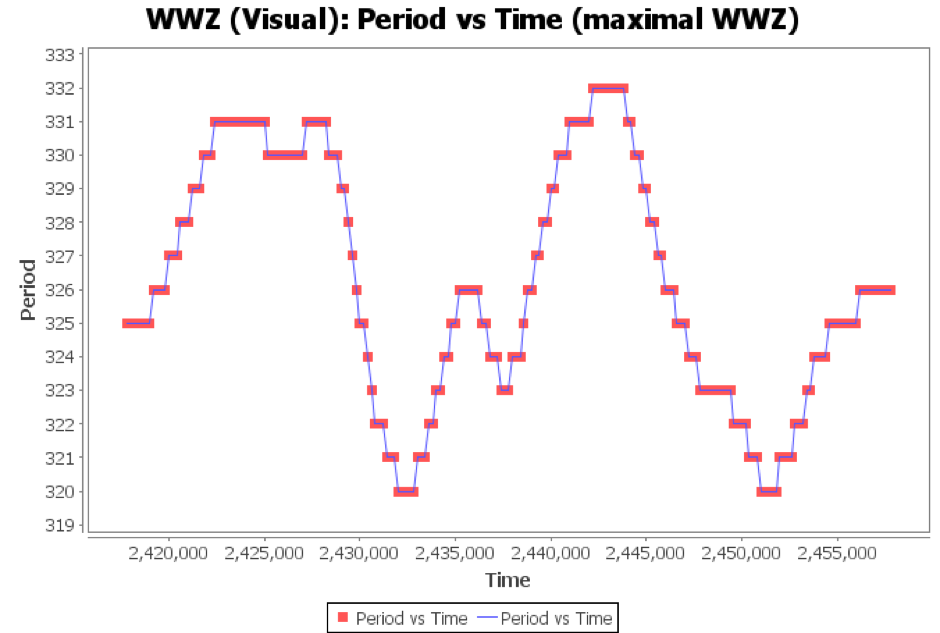U UMi
U UMi is a bright Mira that has been well observed by the AAVSO since 1907. Over 30,000 observations are in the AID from over 850 different observers as can be seen in the light curve shown below which displays all observations in the AID. It is one of the Legacy LPV Program stars.

The light curve based on the last 2,000 days is shown below.

The light curve based on the last 700 days is shown below.

It's spectral class is M6e to M8e according to the VSX and is classified as a Mira. The GCVS lists U UMi as having a visual magnitude range of 7.1 to 13.0 with a period of 330.9 days. However the GCVS does note that there has been changes in the star’s period which appear to be oscillations between a maximum and minimum period. Up until 1913, the GCVS states that the period was 323.1 days, between 1913 and 1940 it was longer at 331.3 days, between 1940 and 1953, it decreased to 320.6 days, between 1953 and 1953 it increased to 331 days, between 1958 and 1965 it decreased to 322.6 days and since 1965 it’s period has been at the quoted duration of 330.9 days. Analysis of all AID data in the period 1907 to the present day indicates an overall mean period of 325.7 days.
Only limited CCD photometry has been reported to the AID. B-V has been measured around 1.5 at both around minimum and maximum.
U UMi is contained in the list of LPV Humps maintained by Frank Schorr as a possible “candidate” for a LPV hump star. It possibly shows a hump in the ascending branch of the light curve. It’s difficult to see this in the phase diagram below based on the visual observations due to the relatively large scatter.

Marsakova and Andronov (2007) analysed a selected group of LPV's which show hump features in their light curves based on 80 year's worth of data from the VSOLJ and AFOEV and U UMi was one of the stars analysed in greater detail. They found that, as with many other LPV's with humps, the humps don’t occur in every cycle. For U UMi, they found that it occurred on average about every second cycle (51 cycles in 100 to be more precise).
They also found that the average duration of the hump was 19 days which represents about 5.8% of the total period. The average phase of the cycle where the hump appeared was 0.24. The phase diagram based on AAVSO observations seems to indicate the phase is about 0.30 where the hump is observed. U UMi has an asymmetrical light curve with the ratio of duration of ascending branch to the total period being about 0.54.
Since the hump duration only averages about 19 days in duration, it is very difficult to see these in the AID data if one considers the light curves above for the last 2,000 and 700 days. So the jury is still out as to whether this star does indeed display definite humps. Further observations at a higher cadence than normally conducted for LPV observations on the ascending branch of the light curve would be very useful to confirm the presence of humps.
An analysis has been performed to ascertain any period changes in U UMi over the past 110 years based on observations in the AAVSO AID. The figure below suggests that there has been a "meandering" of the period between the range of 320 to 331 days. Some of these changes replicate very closely the period changes prescribed in the GCVS mentioned above. This slow meandering behaviour (with period changes general less than 5% of the mean period) is relatively common in the longer period Miras and semi-regular stars.
Percy et al (1999) confirmed that for almost all of the Miras in their large sample (which included U UMi), period changes in the stars are dominated by random cycle-to-cycle fluctuations in period, at least over intervals of about 20 cycles. This makes it very difficult to detect evolutionary period changes using simple O-C diagrams and there is one or more random physical processes going on within the star.

U UMi is an interesting LPV to follow so all are encouraged to maintain the coverage that has been in place over the last 110 years.
References
"Variability of Long Period Variable Stars III: Changes in the Parameters of Humps in the Ascending Branch", V.I Marsakova & I.L Andronov, Astrophysics, Vol 50, No. 1, 2007
“Long Term Changes in Mira Stars. I. Period Fluctuations in Mira Stars”, J. R. Percy & T. Colivas, PASP, 685, 111: 94-97 (1999)

